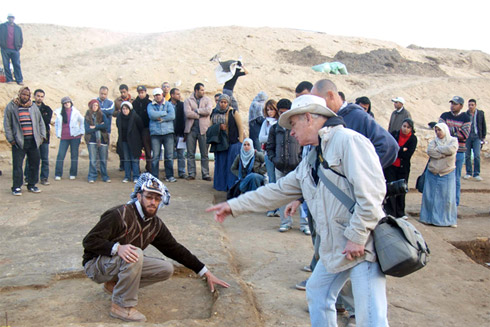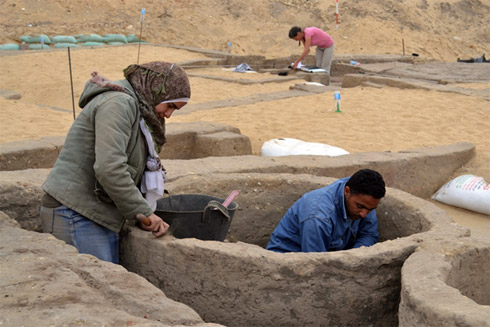By Hanan Mahmoud (MSA archaeologist)
Joining the AERA team at the beginning of March 2014 was one of my dreams. Finally, I could work in the Silo Building Complex (SBC)!
I remember in 2011, after the revolution, my colleague Rabee Eissa and I worked in the Menkaure Valley Temple with the AERA team. By the end of that season and directly to the east of KKT-E basin the workmen exposed rounded silos enclosed with marl brick walls. There were also bins, a kitchen, rooms, corridors and an enclosure wall – all part of a building. Dr Mohsen Kamel, AERA field director, asked me and Rabee to draw this building. Then, we start fighting about who will be the one to get the chance to excavate this amazing Old Kingdom silo building.

A site tour of KKT-E+ area during season 2012. Dr Mark Lehner discusses with Rabee Eissa.
Photo by Sayed Salah.
During our work in Memphis in 2011 (the Mit Rahina Field-school) Mohsen Kamel mentioned that AERA will excavate the Silo Building in the next season. Here starts the trouble again with Rabee who wanted to dig the building and really so do I. I didn’t win this fight! Rabee and Hussein Rekaby excavated the building in sequence during the 2012 season. Really they did great work (link ). Now the days are turned and I am part of the SBC team!
I worked in silos since my first year of work with AERA: first in the Royal Administrative Building at the Heit el-Ghurab site; then in House E of the Khentkawes Town (KKT-N); in Structure 9 in the Luxor Town Mound and finally the silos of the SBC. Actually it is one of my favorite structures. I loved silos since I was young and I saw one in my grandfather’s house. I thought it was a refrigerator.
The 2014 season is a different season we only work on site five days each week starting from 08:00 am till 13:30 pm. On Saturday and during the afternoons we work in the office. As we start our third week of the excavation I am hoping to answer the aims of my 2014 trench (sondage 183) inside the silos (space 11237): to investigate the building phases of the Silo Building Complex (SBC) and identify the relationship between the internal walls of SBC. We are hoping to compare the construction technique of the silos with that of House E in the Khentkawes Town (KKT). I was hoping that we can obtain valuable answer to this question but I am still faraway from achieving that. Working inside the sondage – with small areas behind the silos and inside the silos – is very hard and takes much time. Moreover, it makes you more careful as you might break one of these well preserved silos.
We excavated sequences of packing deposit of ash mixed with pottery sherd and marl brick fragments. We knew that the Ancient Egyptian people used the ash to prevent insects from getting into the silos and eating their stored grain Archaeological evidence for the use of ash as an insecticide uncovered at Amarna, Balat and also in House E – which represents an examples of a construction technique using the properties of ash. Moreover, people in our modern villages still use the same technique of using ash in storage silos. These sequences of dumped ash deposits might also indicate that people were utilizing this packing material to support the silo walls, and prevent them from slumping out because of the pressure of the amount of stored grain.

Hanan Mahmoud and Ahmed Ali work in Space 11237 in the Silo Building Complex during season 2014.
Photo by Sayed Salah.
We need to answer many questions. Do these silos have doors and how were they filled? What is the volume or the capacity of these silos? What kind of grain was stored? Did they store many kind of grain inside? We know from the tomb scenes that silos in Ancient Egypt were usually filled from the top and emptied from the base through a small door. Can we find these doors in our silos?
It was a wonderful day when we found, directly outside the outer edge of one of these rounded silos, an inscribed limestone plaque with the hieroglyphic with word ![]() smyt. This could mean desert or necropolis, and make us wonder if the silo could contain grain allocated to the necropolis. Whether me or Rabee work in SBC I hope we can add a lot of information to what we know of the daily life of the Ancient Egyptian people.
smyt. This could mean desert or necropolis, and make us wonder if the silo could contain grain allocated to the necropolis. Whether me or Rabee work in SBC I hope we can add a lot of information to what we know of the daily life of the Ancient Egyptian people.
